Recent Commercial Posts
Building Safety Month
5/3/2022 (Permalink)
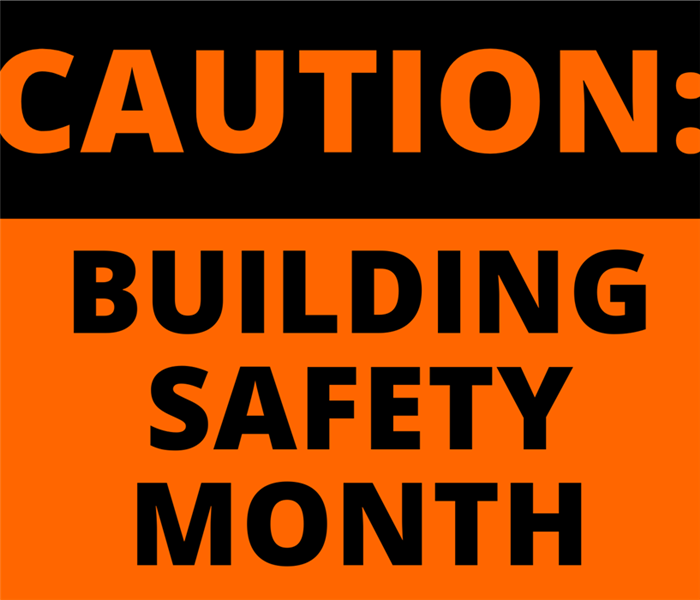
Building Safety Month is an international campaign that takes place annually in the month of May to raise awareness about building safety, according to the International Code Council (ICC) website. This increasingly popular campaign reinforces the need for the adoption of modern, regularly updated building codes, and help individuals, families and businesses understand what it takes to create safe and sustainable structures. This initiative is presented by the International Code Council, a nonprofit association that is focused on building safety worldwide. The Code Council provides a wide range of building safety solutions and develops codes and standards used around the world to construct safe, sustainable, affordable, and resilient structures. All communities need building codes to protect their citizens from disasters like fires, weather-related events such as flooding, and structural collapse. Model building codes, adopted and enforced by well-trained professional code officials, are society's best way of protecting homes, offices, schools, manufacturing facilities, stores, and entertainment venues. The theme for this year's campaign is Safety for All: Building Codes In Action. Regularly updated codes and a strong system of strict code enforcement ensures that individuals and communities are safe in the buildings where they live, work, and play. This campaign is supported by four core themes that will be highlighted throughout the month:
Week 1: Planning for a Safe & Sustainable Tomorrow
Week 2: Exploring Careers in Building Safety
Week 3: Understanding Disaster Mitigation
Week 4: Creating a Safe & Abundant Water Supply To learn more about the weekly themes, check out iccsafe.org.
You can help spread the word about Building Safety Month, the importance of building safety, and the role of code officials with your community! Use the hashtag #BuildingSafety365 to join the global conversation on social media. As always, if your residential or commercial property suffers from structural damage, call your local SERVPRO franchise professionals to help make it "Like it never even happened.®"
COVID-19 CLEANING & DISINFECTING SERVICES
1/10/2022 (Permalink)
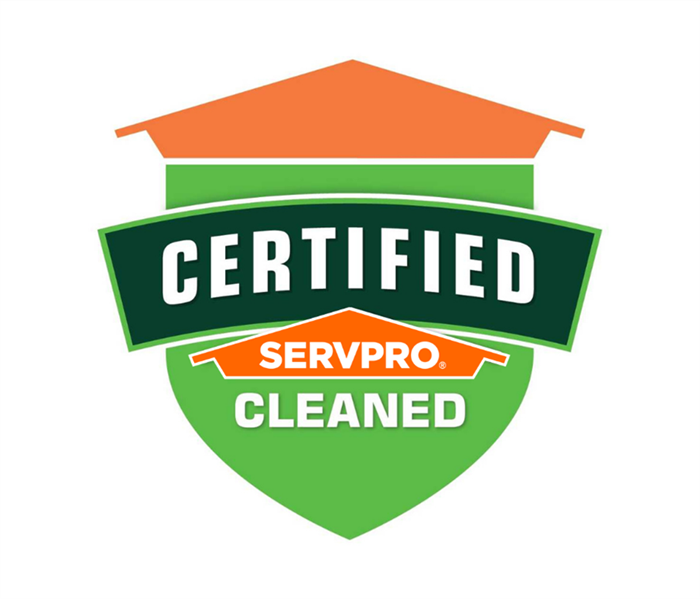 We provide preventative cleaning services as well as cleaning after a probable or proven exposure to assist reduce transmission.
We provide preventative cleaning services as well as cleaning after a probable or proven exposure to assist reduce transmission.
Protect Your Employees & Guests From COVID-19
About Our Services
SERVPRO® of Elmhurst technicians are specially trained to clean and disinfect your home or business according to CDC guidelines. We have years of experience dealing with biological hazards, and we will go above and beyond what janitorial personnel does on a daily basis. Our technicians are qualified to undertake a proactive cleanup that includes cleaning and disinfection of the business or structure. Washing porous and non-porous surfaces, disinfecting non-porous surfaces, cleaning, and disinfecting equipment, tools, and/or supplies used in the cleanup process, and waste disposal are all common cleanup methods.
Residential homes, small and large enterprises, schools and universities, commercial buildings, factories and plants, government facilities, and more can all benefit from SERVPRO's skilled cleaning services. COVID-19 was specifically addressed by our Certified: SERVPRO Cleaned defensive cleaning program. We provide preventative cleaning services as well as cleaning after a probable or proven exposure to assist reduce transmission.
What Chemical Do We Use to Clean?
While we use a range of disinfectants to destroy hazardous bacteria and viruses, SERVPROxide is the disinfectant of choice in COVID-19 cases. SERVPROxide is a hospital-grade disinfectant that has been shown to be effective on hard, non-porous surfaces against viruses like SARS-CoV-2. The CDC has cleared it for COVID-19 cleaning.
Call us today at (630) 758-1701 if your home or business has been exposed to COVID-19
How the Pros Will Clean up Water After a Fire in Your Office Building
12/31/2021 (Permalink)
If you can’t summon help quickly, a fire can quickly sweep through your Elmhurst, IL, office and leave a trail of devastation in its wake. Fire damage can be severe and make it impossible for you to resume work duties in your building. Ironically, the very water firefighters use to eliminate the fire can also cause major problems. Trained professionals have the equipment and skill to clean up both types of damage.
Thorough Inspection
When you call a professional disaster cleanup crew to your office, the team won’t jump right in and start working without a plan. The company will evaluate the effects of the fire damage in order to come up with an effective strategy. The technicians will do the following:
• Make note of which areas of your building were affected.
• Determine the extent of the damage.
• Decide what areas and items you can salvage and which ones you must replace.
• Establish a plan of attack that will yield the most complete, time-effective results.
Remove Standing Water
A fire hose can pump out hundreds of gallons of water while a firefighter is battling a blaze. It’s no wonder water can wreak havoc in your office after a fire. A technician will use wet vacuums and other specialized water removal equipment to make sure there is no leftover water on your floor or on furniture or other objects. Next, the team will dry the areas with dehumidifiers and high-powered blowers.
Clean and Sanitize
Sucking up water and drying the area isn’t enough to mitigate water damage. The professionals will also use chemicals to thoroughly sanitize any areas where there had been water. This will minimize the chances of mold growth.
Fire damage and water issues go hand in hand after a fire. By understanding the process the pros use, you can have peace of mind and confidence that your office will be in good hands.
Emergency Ready Program for your business
9/29/2021 (Permalink)
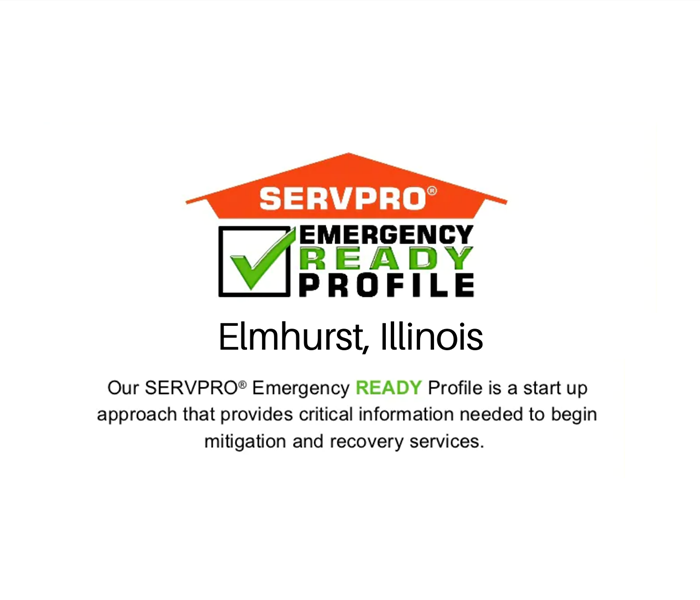 Join our Emergency Ready Program today!
Join our Emergency Ready Program today!
Are you and your clients “Ready for whatever happens?”
If an emergency situation arises in your workplace, give us a call and we'll be there as soon as possible to help.
We're here for you 24 hours a day, 7 days a week to get your business back on track! Our experience includes fire and water damage restoration, while also electronics restoration and document drying.
Our professionals are trained to be aware of legal and environmental issues while working within your budgetary constraints to repair the affected area. We understand that every hour spent cleaning is an hour of lost revenue and productivity.
Preparation is essential for surviving any major disaster, whether it's a minor water leak, a large fire, or a widespread flood. The greatest time to prepare for such tragedies is before they occur.
By becoming a member of our SERVPRO of Elmhurst Emergency READY Program (ERP), you will get access to over 40 years of experience in lessening the impact of natural and man-made disasters.
Give us a call today to schedule your Emergency Ready Program (630) 758-1701!
National Preparedness Month
9/13/2021 (Permalink)
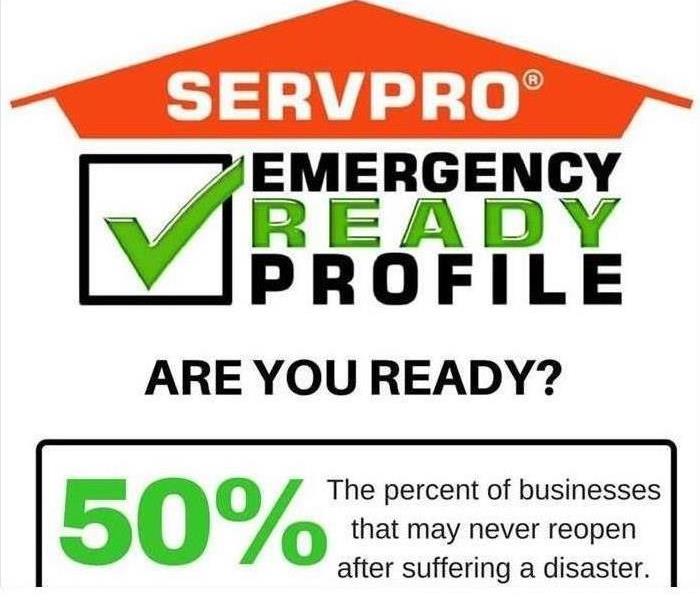 Be prepared!
Be prepared!
As a business owner, insurer or property manager, you are a leader in your community! Therefore, you have the opportunity to set an example to others around you. September is National Preparedness Month (NPM), and this year we are encouraging you all to join your community in preparing for emergencies and disasters. You can do so by leading the efforts to encourage your community to become more prepared as a whole. Disasters WILL HAPPEN, and not only do they devastate neighborhoods, but entire communities including local businesses of all sizes.
As an employer in your community, having a business continuity plan can help protect your company. It can also maximize your chances of recovery after a disaster takes place. There are 3 simple steps to take.
1. Plan to stay in business
2. Encourage your employees to become ready
3. Protect your investment
There are many supporting resources available that can begin to prepare your business for a disaster. We here at SERVPRO can help your business with our Emergency READY Profile (ERP). Here are some of the advantages of our ERP program.
- A no-cost assessment of your facility.
- A concise profile document that contains only the critical information needed in the event of an emergency.
- A guide to help you get back into your building following a disaster.
- Establishes your local SERVPRO franchise professional as your disaster mitigation and restoration provider.
- Identification of the line of command for authorizing work to begin.
- Provides facility details such as shut-off valve locations, priority areas, and priority contact information.
Preparation is KEY to making it through any size disaster, whether it is a small water leak or a large fire. The best time to plan is not when the event happens, but well before it takes places. No one ever plans on a disaster, but you now can plan for it and be prepared. Call us today to set up your very on Emergency READY Profile!
Commercial Cleanup
9/13/2021 (Permalink)
If you can’t summon help quickly, a fire can quickly sweep through your Elmhurst, IL, office and leave a trail of devastation in its wake. Fire damage can be severe and make it impossible for you to resume work duties in your building. Ironically, the very water firefighters use to eliminate the fire can also cause major problems. Trained professionals have the equipment and skill to clean up both types of damage.
Thorough Inspection
When you call a professional disaster cleanup crew to your office, the team won’t jump right in and start working without a plan. The company will evaluate the effects of the fire damage in order to come up with an effective strategy. The technicians will do the following:
• Make note of which areas of your building were affected.
• Determine the extent of the damage.
• Decide what areas and items you can salvage and which ones you must replace.
• Establish a plan of attack that will yield the most complete, time-effective results.
Remove Standing Water
A fire hose can pump out hundreds of gallons of water while a firefighter is battling a blaze. It’s no wonder water can wreak havoc in your office after a fire. A technician will use wet vacuums and other specialized water removal equipment to make sure there is no leftover water on your floor or on furniture or other objects. Next, the team will dry the areas with dehumidifiers and high-powered blowers.
Clean and Sanitize
Sucking up water and drying the area isn’t enough to mitigate water damage. The professionals will also use chemicals to thoroughly sanitize any areas where there had been water. This will minimize the chances of mold growth.
Fire damage and water issues go hand in hand after a fire. By understanding the process the pros use, you can have peace of mind and confidence that your office will be in good hands.
Disaster Plan for Your Business
7/8/2021 (Permalink)
 Have a plan!
Have a plan!
When it comes to owning a commercial business, you need to make sure you have a disaster plan in place. Natural disasters don't give you a warning to get out in time, and sometimes you only have minutes to act fast. One natural disaster that most people are not prepared for are earthquakes. Here are 6 steps to prepare you if an earthquake where to take place.
1. Assess the Earthquake Risk of Your Building
You need to get a clear picture about your business' earthquake risk factors. You need to know how ready or NOT ready your business is. It is recommended that all businesses perform risk assessments that find the strong and weak points of your plan. You should also schedule a consultation with an experienced firm to elevate the structural integrity of the building.
2. Create a Disaster Plan
These should be created and distributed to all of your employees beforehand. It is important to include ALL of you employees as you are developing a disaster plan. This way they if they notice any signs of an earthquake, they will know exactly what to do. Some of the things your disaster plan should include are:
- Contact information for all employees
- Communication plan
- Talk with employees with disabilities and make arrangements
- Hotline or text message system
- Schedule regular earthquake response drills to practice
- Emergency kit
- Safety checklist
3. Identify Your Building's Potential Structural Issues
Every business is different, and there is no one-size-fits-all approach. You will need to evaluate every aspect of your business and make preparations that are unique to your building's property. You need to understand the risks and take specific actions to help prevent earthquake disasters for your business, and to also protect your staff.
4. Bring in Expert Advisors
You can't afford to waste your time on hearsay or just anyone's word. Your business, life, and the lives of your employees and customers depends on doing things correctly and being truly prepared. Make sure you choose a reputable earthquake retrofitting contractor based on years of experience and high ranking results. This way it can translate to lives and business saved in those areas.
5. Develop a Comprehensive Emergency Communications Plan
Keeping your business in business after an earthquake often depends on effective communication. Be sure you have a plan in place that takes everyone into account. This includes your employees, your customers and your suppliers. Make sure you set up a backup communications plan that enables you to keep lines of communication open, even if you are unable to access your building. Make sure you employees know who to contact before hand so they aren't calling people they shouldn't have to call. Maintain an emergency contact list with police, fire, ambulance, hospital and other emergency services that employees know how to access quickly. Also, have your insurance company and attorney's numbers in a secure place.
6. After the Earthquake
Remember that it might not be readily apparent whether your building is safe after an earthquake takes place. There are usually aftershocks for hours and days afterward. Be sure to contact an experienced expert first for an earthquake damage safety assessment before you allow employees and customers back into the building.
Commercial Property
1/10/2021 (Permalink)
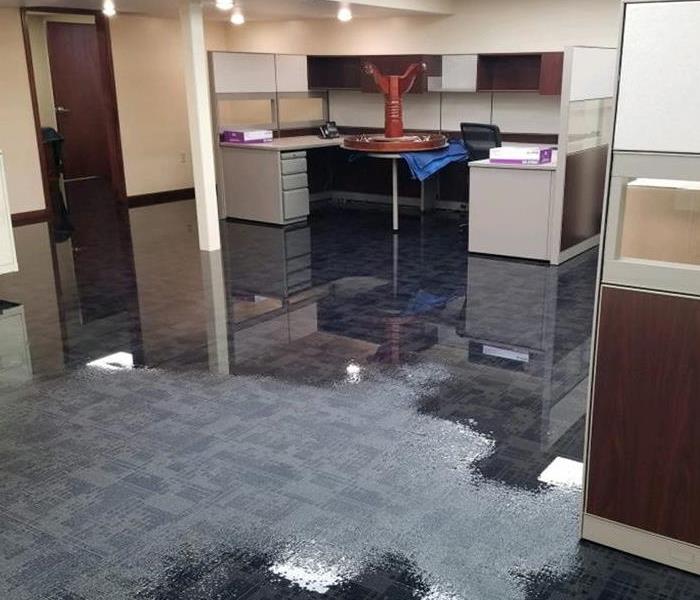 Commercial Property
Commercial Property
You want your business to make as much profit as possible, but you may be losing money without even realizing it. Leaks from damaged pipes, as well as other areas, are a common source of trouble in many buildings. It is important to perform regular inspections to make sure everything is in top condition. Here are a few problems that might end up costing you money.
1. Damaged Roofing
Leaking pipes are not the only potential source of excess water. The roof is an important part of the structure of your business, as it protects you from severe weather and keeps the inside of the building dry. However, if you do not properly maintain your roof, you could end up with a lot of damage. In some cases, the structure of the building may weaken or a mold growth might develop. Make sure to regularly check the condition of your building and perform repairs as needed.
2. Broken Appliances
Another common source of water is from broken appliances. The damage here can range from a small leak to a lot of flooding. One way to prevent this is to test your equipment regularly to ensure it is in proper working condition. As items begin to age and break down, replace them to prevent any significant problems.
3. Pipes and Plumbing
Damaged pipes can sometimes be a hidden source of wasted water and money. If you are not performing regular maintenance, a persistent leak could end up costing hundreds or thousands of dollars in extra water bills. Leaks can also indicate aging pipes that could cause a lot of damage if not replaced.
Performing regular maintenance in your building is a great way to locate problems and prevent big issues from leaks or damaged pipes. If you do experience damage, however, a water restoration company can perform necessary repairs to your building and belongings.
Commercial Cleanup!
9/29/2020 (Permalink)
If you can’t summon help quickly, a fire can quickly sweep through your Elmhurst, IL, office and leave a trail of devastation in its wake. Fire damage can be severe and make it impossible for you to resume work duties in your building. Ironically, the very water firefighters use to eliminate the fire can also cause major problems. Trained professionals have the equipment and skill to clean up both types of damage.
Thorough Inspection
When you call a professional disaster cleanup crew to your office, the team won’t jump right in and start working without a plan. The company will evaluate the effects of the fire damage in order to come up with an effective strategy. The technicians will do the following:
• Make note of which areas of your building were affected.
• Determine the extent of the damage.
• Decide what areas and items you can salvage and which ones you must replace.
• Establish a plan of attack that will yield the most complete, time-effective results.
Remove Standing Water
A fire hose can pump out hundreds of gallons of water while a firefighter is battling a blaze. It’s no wonder water can wreak havoc in your office after a fire. A technician will use wet vacuums and other specialized water removal equipment to make sure there is no leftover water on your floor or on furniture or other objects. Next, the team will dry the areas with dehumidifiers and high-powered blowers.
Clean and Sanitize
Sucking up water and drying the area isn’t enough to mitigate water damage. The professionals will also use chemicals to thoroughly sanitize any areas where there had been water. This will minimize the chances of mold growth.
Fire damage and water issues go hand in hand after a fire. By understanding the process the pros use, you can have peace of mind and confidence that your office will be in good hands.
Costs from water damage
9/1/2020 (Permalink)
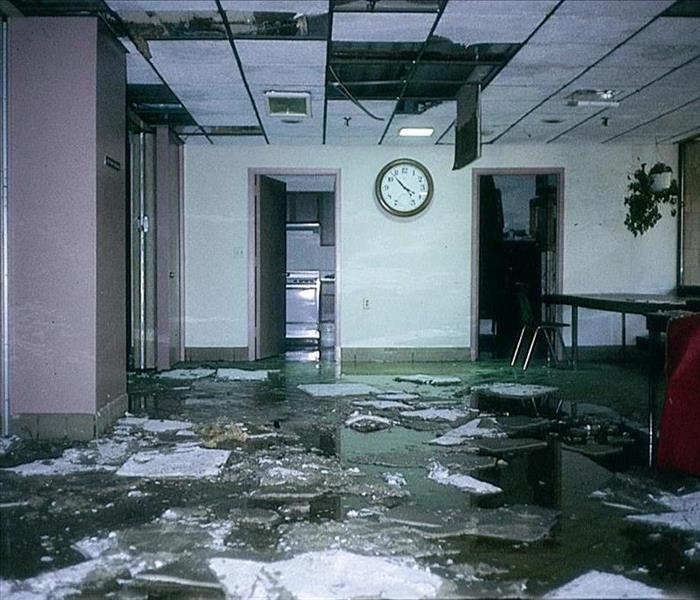 Call our SERVPRO team today!
Call our SERVPRO team today!
When it comes to owning a business or a home, water damage can be one of the most costly things there is. You can not only lose out on days or weeks of productivity, but you could also find yourself repairing or replacing valuable equipment like electronics, tools and inventory. This is where the costs come into play.
- On average, water damage from a sink will run $7,000.00 for each instance
- For toilets, that number ranges between $2,000.00 and $10,000.00
As we can see, this can add up very fast! Here are some causes of water damages, and what you can do to help prevent them.
1. Appliances and Equipment
- Air conditioners, water heaters or anything that uses tubes, pipes, gaskets or filters to operate has the potential to leak. The best thing to do is to regularly look over and maintain your equipment. If you notice anything that concerns you, such as rust, cracks, bulges or signs of moisture, call SERVPRO.
2. Roofing
- Make sure you're checking your roof regularly. If you've got a pond up there, your drainage isn't working effectively. Keep in mind that every inch of water weighs in at around 5 lbs. Be sure to look for any damage to your perimeter like flashing, roof membrane or roof penetrations like drains, pipes and gas lines.
3. Pipes and Drains
- Your plumbing system is susceptible to stoppages, clogs and damage. If a crack develops, it could dump 250 gallons of water per day on your facility. Look for outward signs of moisture, blue stains, rusting, and cracking and bulging. If you're having plumbing work done or you have a cut pipe for any reason, check for scale buildup. You can also try a pipe camera to get a good look at what's going on inside your system.
4. Sprinkler Systems
- Many commercial buildings are outfitted with sprinkler systems, which are great for minimizing fire damage, but not so great for water damage when they malfunction. Always check your sprinkler system for signs of damage or rust, and replace them regularly to make sure they are functioning properly.
5. Mother Nature
- Natural disasters like hurricanes, severe thunderstorms and flash flooding can do untold damage to your business. You can control how ready you are for it though. Keeping your gutters clear, installing barriers and storing sensitive files and electronics at a higher level are all things you can do to keep the damage minimal. Consult with a SERVPRO professional to get your ERP set up and ready in case something like this were to happen.
Common Causes of Commercial Building Fires
9/1/2020 (Permalink)
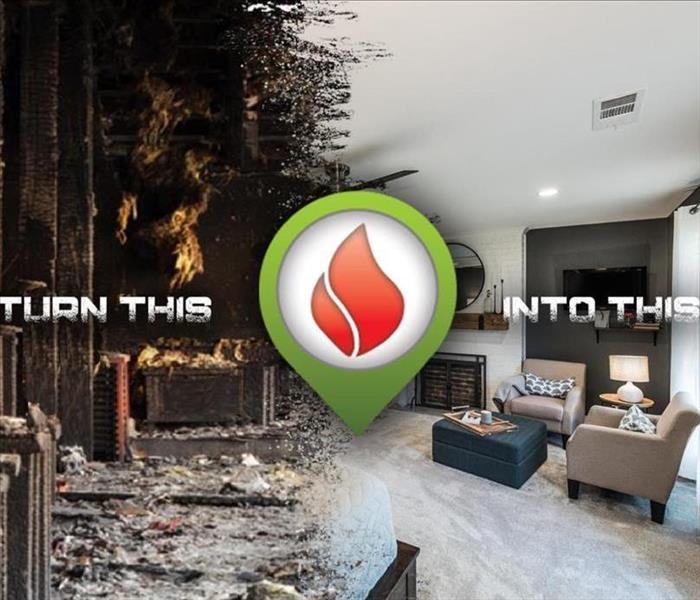 Make sure to check all heating sources!
Make sure to check all heating sources!
We usually don't think of a fire destroying our business or office building. We are more worried about less concrete threats. This includes a downward trending economy, high customer churn rate, the struggle to retain talented employees, legal issues, etc. However, nonresidential building fires killed 65 people, injured 1,425 and created $2,461,400,00 in damage between 2004 and 2013.
In order to prevent a dangerous and costly fire, the time of day fires are most likely to occur in your building depends on what type of business you're in. An office building is a bit different from a manufacturing plant. Ex: In an office building, fires are most common during regular work hours. Incidence of fires peaks in the early evening hours between 3-6pm.
Therefore, the most common causes of commercial building fires are as follows.
1. Cooking Fires
- 29.3% of nonresidential fires from 2013 were cooking related. In fact, 1 in 4 office building fires were related to cooking equipment. These types of fires do tend to account for less damage, but they are easily preventable with fire protection systems such as alarms and fire extinguishers.
2. Intentional
- This accounts for almost 10% of fires, and tends to cause the most damage. Intentional fires also result in more civilian injuries and deaths. Unlike cooking and heating fire, it's most common for intentional fires to be started between 3pm and midnight. A few common locations to be aware of in the building are bathrooms, trash bins, garages, and open areas like a lawn or field.
3. Careless Acts and Human Error
- 9.2% of commercial fires were unintentional results of careless acts. This is somewhat of an 'other' category. Some examples include accidentally leaving space heaters or other heat producing equipment on, carelessly discarded cigarette butts igniting fires, and plugging too many things into the same extension cord.
4. Heating Fires
- Heating fires account for 9% of all nonresidential building fires. Central heating units, fireplaces, water heaters, and other heating appliances and systems should be regularly inspected to prevent fires. It is important to move any flammable materials and furniture away from heat sources.
Certified: SERVPRO Cleaned Program
7/23/2020 (Permalink)
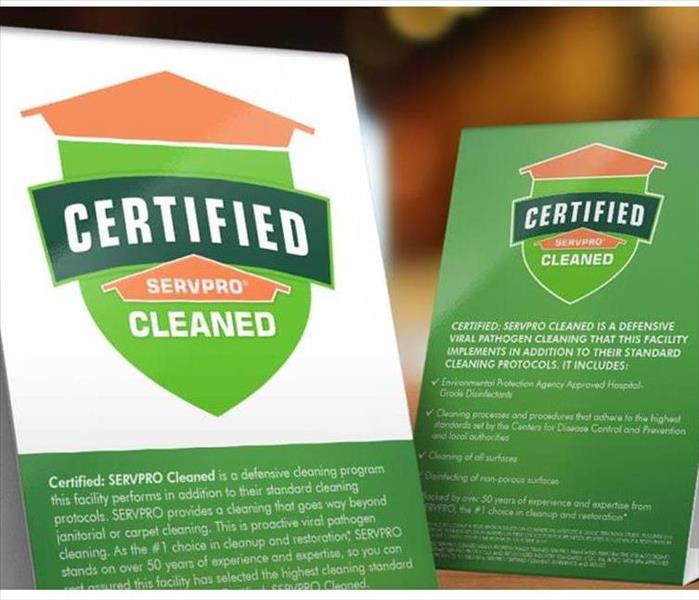 Get set up today!
Get set up today!
We as a company have recently introduced our new program Certified: SERVPRO Cleaned, and it is designed to provide our communities with a way to know that a structure has been cleaned, sanitized, and disinfected. This is also a cleaning and disinfecting program that we here at SERVPRO have to offer for our commercial property owners in order to address the current COVID-19 pandemic. We ensure that when businesses choose SERVPRO, their customers, employees, and community are rest assured that they have selected a higher standard of cleaning.
This program is set up with 3 unique steps called the 3 C's. These 3 C's include Consult, Clean, and Certify.
Consult deals with the process of talking to each businesses personally because not all businesses are the same. A SERVPRO professional who understands the business will create a custom cleaning program to meet their specific needs. The specific program will be developed based on a range of factors including business type, size of space, amount of high frequency touch points, foot traffic, and congestion points. Therefore, they will know that the clean they receive is customized to their unique needs.
Clean is based on the specific needs of their business, and their location will undergo a thorough expert cleaning rooted in the pillars of People, Process, and Product.
-People: SERVPRO professionals are uniquely prepared during this unprecedented time to clean and disinfect homes or businesses according to the protocols set by the CDC. We have years of experience in dealing with biological contaminants, and we will go beyond the scope of work that needs to be done.
-Process: SERVPRO professionals are trained to perform proactive or emergency responsive cleanups that involves facility or structure cleaning and disinfection. This would include cleaning of porous and non-porous surfaces, disinfecting of non-porous surfaces, cleaning and disinfecting of equipment, tools and supplies used for cleanup, and disposal of hazardous materials. We also recommend a frequent cleaning depending on what CAT it is in. We want to make sure that people are getting back to business as soon as possible if there is a known COVID-19 case involved.
-Product: Our program has more than 100 exclusive professional cleaning products to meet any need. This includes our proprietary cleaning agent, SERVPROXIDE, which is a hospital-grade disinfectant that carries the Environmental Protection Agency's lowest toxicity category and is NSF certified for sanitizing surfaces in and around food processing surfaces.
Certify deals with the our credibility as the premier biohazard cleaning company in the country to their business. This then allows assurance to their employees and customers that only SERVPRO can deliver. Once the business has been cleaned, they will gain access to propriety signage, digital emblems, and other collateral that communicates that they've selected the highest standard of cleaning available to protect their employees and customers. We also have the option to add the date, so then their guests will know that their location is being cleaned regularly.
SERVPRO professionals have been on the front lines of proactive and reactive COVID related cleanups, and we are here to help as businesses begin to reopen and to also help them stay open!
How To Avoid Mold in Your Restaurant
1/8/2020 (Permalink)
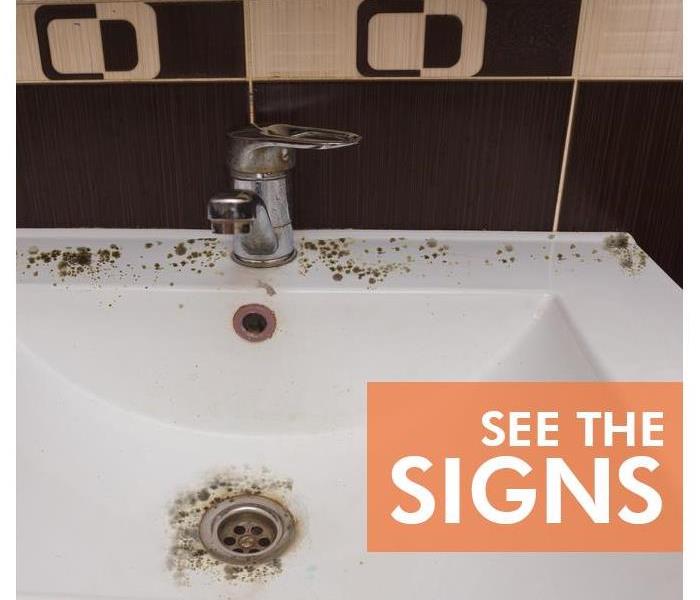 Visible signs of mold growth and moldy, musty odors are a sign of moisture or water damage.
Visible signs of mold growth and moldy, musty odors are a sign of moisture or water damage.
How To Avoid Mold in Your Restaurant
If you own and operate a restaurant, there are certain things you never want to hear. You don't want to hear a customer complain about the food, you don't want to hear about poor service, and you certainly don't want to find out there is mold growth. Few things could turn people away from your establishment faster than the sight of this fungus. Unfortunately, restaurants are a prime place for mold to invade and spread. If you are vigilant, you can prevent it from entering your place.
Places To Check
Mold loves places where there is high humidity, so start looking near sinks and in crawl spaces, cellars and closest for signs of growth. You may even spot mold in some of the following areas of your building:
- Bathrooms, including employee showers and locker rooms
- Behind and under refrigerators and other appliances
- Near the HVAC system
How it Grows
Water is one of the biggest culprits of mold development. Fungi and water go hand in hand, so be aware of any water damage you may have suffered in your Elmhurst, IL, restaurant. Leaky pipes can attract mold, as can overflowing sinks. Make sure you clean up water promptly and make any necessary repairs. A professional water damage restoration team can also help. These crews will not only remove water but will kill any bacteria left behind with powerful sanitizing agents.
Stop the Spread
If you ever detect mold growth in your facility, make sure you check your ventilation system. Proper airflow can reduce humidity, especially while you are doing dishes and preparing food. Properly refrigerate all items and dispose of materials before the expiration date. Conduct a thorough walk-through of the restaurant at the end and beginning of each workday.
Take the time and make the effort to stop mold growth. Your business can thrive as mold stops dead in its tracks.
How To Temporarily Repair A Wind-Damaged Roof
12/23/2019 (Permalink)
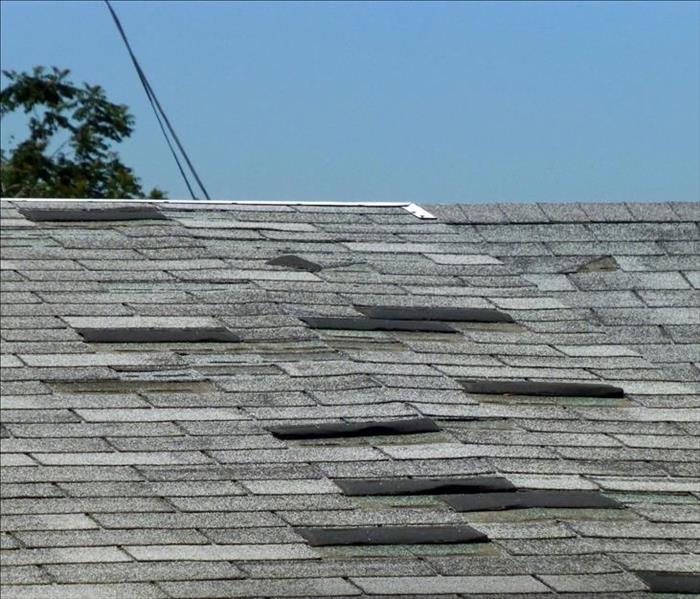 Missing shingles on roof
Missing shingles on roof
Three Steps To Prevent Roof Damage
A roof leak or other wind damage to the roof of your Schiller Park, IL, business can be a major headache. Fortunately, there are steps you can take to prevent further damage.
Signs of Wind Damage
It is important to address roof damage as quickly as possible. The following are some common signs of a damaged roof:
- Curling, lifted or missing shingles
- Damaged or absent chimney flashing
- Leaking roof
- Buildup of shingle granules in gutters
Few roofs are completely flat. Most have a variety of geometric features that affect where damage occurs. Wind damage is most likely to occur along the edges of the roof, at the corners and along the ridge line. Be sure to check those areas closely after heavy winds.
Temporary Roof Repair
Although you will need to permanently repair the roof, you may have to do a quick fix to prevent further damage or stop a roof leak. The following are three common temporary roof-repair methods:
- Tarp over or board up the damaged area
- Readhere curling or lifted shingles
- Make temporary shingles from sheet metal
Using tarpaulin or plywood to cover the affected area of your roof is generally inexpensive and fairly easy. If you just have a few damaged shingles, though, you may be able to readhere them with roofing cement. You will need a heat gun to soften the shingles and make them more malleable. You will also need roofing nails to secure the shingle. If you have missing shingles, you can make replacements fairly easily using sheet metal. Simply cut the sheet metal into the same shape as your regular shingles and install them as you would any other shingle.
Addressing roof damage as soon as possible can prevent further damage to both the roof and the interior of your business. However, if you do have water damage or mold growth from a roof leak, a certified restoration company can help you get your business back to normal quickly and safely.
Maintain the Old Pipes in Your Rental Property
9/26/2019 (Permalink)
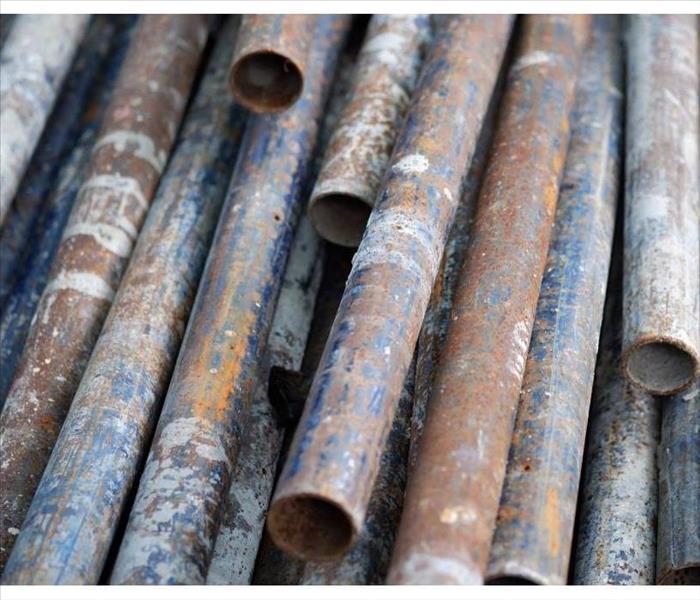 Maintain the old pipes
Maintain the old pipes
When property owners in Melrose Park, IL, take on an older house or complex, they are also liable for the problems with them. One of these issues is their plumbing system, which can sometimes consist of polybutylene pipes and have a greater tendency to deteriorate or clog. If you are considering renting out an older building, you should be aware of the risks associated with this system and prepare a maintenance routine to keep it functioning.
Potential Problems With Old Pipes
These old pipes are usually made of unreliable or outdated materials that create more problems than they solve. For instance, lead pipes can pollute the water, while rusty piping can make the water take an unpleasant smell and a brown color. A common issue with older houses and rental complexes, particularly those built between 1978 to 1995, is polybutylene piping. This material was popular because it was cheap and easy to install, but its interaction with chlorine creates brittleness and later, water damage. Commercial building restoration services can assist you should this incident occur.
Detect and Treat Clogs
Older pipes are prone to clogs and blockage, which are an inconvenience to tenants and clients in your property. There are several unclogging options for these old pipe systems.
- Snake or wire
- Plunger
- Chemical cleaners
- Enzyme and hot water mix
Determine the severity of the clog before attempting these treatments.
Maintain the Old Pipes
Replacing these pipes is not always a realistic option. Sometimes, the practical action is using a monthly maintenance routine while a permanent replacement is planned. Keep the pipes unclogged with an enzyme and warm water mix. Run hot water down, then pour the enzyme mix and let it sit overnight. Afterwards, flush it down with more hot water to flush the contents down.
The outdated pipes in your Melrose Park, IL, rental property, whether they are made of polybutylene or another material, can endanger the property and your rent business. Protect both by actively maintaining and repairing the plumbing system.
Treating Workplace Burns: The Do's and Don'ts
8/13/2019 (Permalink)
 Avoid popping burn blisters
Avoid popping burn blisters
Burns in the workplace are more common in some industries than others. Whether it be from fire damage or hot equipment, being prepared for these emergency situations can go a long way in keeping your employees safe and comfortable under unfortunate circumstances. If a serious burn takes place, here are some things to do (and not do) until Hillside, IL, medical personnel arrive.
What To Do
Move the injured individual away from danger. First and foremost, get everyone to safety. If there is fire damage in the building, try to get everyone outside to safer surroundings. This will prevent further injuries.
Elevate wounds. Keeping burns above heart level, when possible, can help to reduce swelling and keep pain at bay. Circulation is key to quickly addressing severely burned skin.
Make them comfortable. While you don't want to do anything too drastic in the case of a major burn, applying basic burn first aid can help the injured person to be more comfortable while you wait for help. Remove tight clothing or jewelry around the affected area. Apply a cool, clean cloth to blistering skin. Offer over-the-counter pain reliever and water to ease the pain.
What To Avoid
In addition to applying first aid, avoid these common mistakes that often make things worse:
Water submersion. Rather than submersing the individual with water, apply cool damp cloths or bandages only where the skin is affected. Water submersion may send the individual into shock or hypothermia if their body temperature drops too rapidly.
Popping burn blisters. When severe burns occur, it is common for the skin to bubble-up into red hot blisters. Although they may look irritated, never pop or break the skin intentionally. Doing so may lead to infection.
Ice cold water. While cooling the burn with cool compresses is recommended, ice cold water should never be used. After a burn occurs, very cold water can cause tissue damage to the already injured skin. Use lukewarm to cool water instead.
Facing the Aftermath
After the smoke has cleared and fire damage cleanup ensues, be sure to keep tabs on injured employees. A little encouragement can go a long way in the recovery process after experiencing a major burn.
Could Mold Be Growing in Air Vents?
8/12/2019 (Permalink)
Savvy business owners in Elmhurst, IL, understand the importance of maintaining the integrity of the building from which it operates. During an inspection, a common culprit to look for is mold. While the focus may be in areas prone to dampness, like air-conditioners and windows, a ventilation system should not be overlooked. Regular HVAC Cleaning can help keep mold from making its home in air ducts.
Causes of Growth
Mold spores drift through the air searching for an ideal location to take root and reproduce. They require food, water and stable temperatures to flourish, which makes HVAC systems an ideal location for it to call home. The purpose of these systems is to balance temperature. As the air blows, dust scatters through the system, providing sustenance for mold. Regular HVAC Cleaning can help limit that food source. If there is a leak or condensation in the system, mold has all it needs to begin its continuous reproductive cycle.
Signs of Trouble
While cleaning vents should be done regularly, it can easily move down the to-do list. When that happens, some telltale signs of mold can help you put it to the top of the list.
• Mold has a strong, unique smell. If it is noticeable in multiple areas, or stronger when the HVAC system is on, it could be growing in the vents.
• Although you may not be able to see it in the venting system, it may be evident inside the grate or around vents and registers.
• If you notice any signs of moisture around vents or in the ceiling, call a professional to find the source of the problem.
Prevention is the key to eradicate mold. HVAC Cleaning not only keeps the system operating properly and efficiently, but it also helps remove elements that mold thrives on. Along with regular cleaning, changing filters and clean drip pans can decrease the chances of mold forming.
How To Tell When Storm Damage Is Tax Deductible
7/15/2019 (Permalink)
The aftermath of devastating natural disasters can leave behind hefty damage to the property of your business. Luckily, these damages can sometimes be tax-deductible, allowing business owners in the Elmhurst, IL, area who have been hit hard by Mother Nature to receive financial help from Uncle Sam.
What Is Not Covered
While plenty of storm-related damage can be written off during tax season, there are some blanket disqualifications. You typically cannot deduct these expenses:
• Natural wear and tear unrelated to any storm damage
• Minor damages
• Costs reimbursed by insurance
Additionally, failing to file a claim for property covered under the insurance will disqualify a business from any deductions for damage done to that property. Contact your insurance agent immediately after the storm and fill out any required paperwork.
Calculating Damage for Each Property
In order to calculate the total amount you can claim to the IRS, you must first find the actual property loss of each item in question. This can be estimated by subtracting any salvage value after the event from the value of the property at the time of the storm damage, which will be less than what you paid for it. For example, a vehicle purchased at $30,000 may be worth only $5,000 by the time it is damaged in a disaster. If the damaged vehicle has a salvage value of $1,000, that would leave only $4,000 in casualty losses since some of the original $5,000 was offset with the new valuation. Subtract any additional payouts from insurance for the final amount.
Additional Considerations
If damage to your property is due to a presidentially declared disaster, you can file for a deduction in either the year of the disaster or the following year. If a business receives a payout at a greater monetary value than the worth of the property itself, the business may need to report again on the action when filing.
When hit hard by storm damage, tax deductions are probably the last thing on your mind. However, keeping track of expenses incurred with storm damage restoration services may allow you to save your business some money in April.
What Is Category 3 Water Damage and How To Recover From It
6/30/2019 (Permalink)
There is so much to consider when you experience flood water at your business in Elmhurst, IL. One of the many considerations is what category the water is and what kind of recovery the resulting level of damage requires. The worst possibility is category 3 water. It is important to understand what you are dealing with and how to protect yourself and employees.
What Is Category 3 Water Damage?
Category 3 water damage is the unhealthiest level. It occurs when highly contaminated water, or flood water, infiltrate materials such as wood and sheetrock, leading to poor environmental conditions. This type of liquid can come from broken sewer lines, severe weather conditions, flash floods, backed-up sewer mains, and even toilet overflow.
Why Is Category 3 Water Damage Dangerous?
There are serious health concerns involved with category 3 water damage. The highly contaminated black water can carry pathogens that can lead to communicable diseases such as hepatitis, tetanus, HIV, tuberculosis, and West Nile virus. The water can spread quickly through a building, making it very difficult to properly clean up all the materials in which it can permeate.
How Does a Business Recover from Category 3 Water Damage?
To recover from a flooding event, it is important to allow a professional company specializing in water damage repair to thoroughly clean your building. Make sure the company is certified in category 3 damage. These professionals can ensure you meet OSHA and EPA standards at your place of business for the sake of all employees. If possible, move your workplace to another location during the cleanup process. Using a professional cleaning company can help reduce the spread of pathogens, aid in the reconstruction of damaged structures, and help with recovering salvageable materials and personal belongings.
Cleaning up from a flood water event in your business is not easy. Do not risk your health and the health of your employees by trying to restore category 3 water damage by yourself. Call a professional instead.
How the Pros Will Clean up Water After a Fire in Your Office Building
6/25/2019 (Permalink)
If you can’t summon help quickly, a fire can quickly sweep through your Elmhurst, IL, office and leave a trail of devastation in its wake. Fire damage can be severe and make it impossible for you to resume work duties in your building. Ironically, the very water firefighters use to eliminate the fire can also cause major problems. Trained professionals have the equipment and skill to clean up both types of damage.
Thorough Inspection
When you call a professional disaster cleanup crew to your office, the team won’t jump right in and start working without a plan. The company will evaluate the effects of the fire damage in order to come up with an effective strategy. The technicians will do the following:
• Make note of which areas of your building were affected.
• Determine the extent of the damage.
• Decide what areas and items you can salvage and which ones you must replace.
• Establish a plan of attack that will yield the most complete, time-effective results.
Remove Standing Water
A fire hose can pump out hundreds of gallons of water while a firefighter is battling a blaze. It’s no wonder water can wreak havoc in your office after a fire. A technician will use wet vacuums and other specialized water removal equipment to make sure there is no leftover water on your floor or on furniture or other objects. Next, the team will dry the areas with dehumidifiers and high-powered blowers.
Clean and Sanitize
Sucking up water and drying the area isn’t enough to mitigate water damage. The professionals will also use chemicals to thoroughly sanitize any areas where there had been water. This will minimize the chances of mold growth.
Fire damage and water issues go hand in hand after a fire. By understanding the process the pros use, you can have peace of mind and confidence that your office will be in good hands.
About SERVPRO of Elmhurst
7/25/2017 (Permalink)
SERVPRO of Elmhurst specializes in the cleanup and restoration of commercial and residential property after a water damage event. Our staff is highly trained in property damage restoration. From initial and ongoing training at SERVPRO corporate training facility to regular IICRC-industry certification, rest assured our staff is equipped with the knowledge to restore your property.





 24/7 Emergency Service
24/7 Emergency Service












